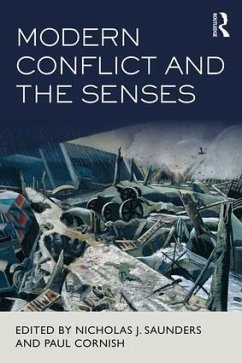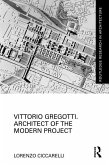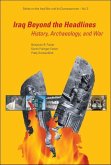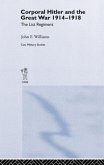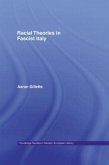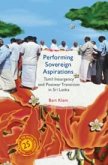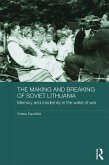Modern Conflict and the Senses
Herausgeber: Saunders, Nicholas J; Cornish, Paul
Modern Conflict and the Senses
Herausgeber: Saunders, Nicholas J; Cornish, Paul
- Gebundenes Buch
- Merkliste
- Auf die Merkliste
- Bewerten Bewerten
- Teilen
- Produkt teilen
- Produkterinnerung
- Produkterinnerung
Modern Conflict and the Senses investigates the sensual worlds created by modern war, focusing on the sensorial responses embodied in and provoked by the materiality of conflict and its aftermath. The volume positions the industrialized nature of twentieth-century war as a unique cultural phenomenon that embodies the extremes of human behaviour, from total economic mobilization to the unbearable sadness of individual loss. Adopting a coherent and integrated hybrid approach to the complexities of modern conflict, the book considers issues of memory, identity, and emotion through wartime experiences of tangible sensations and bodily requirements.…mehr
Andere Kunden interessierten sich auch für
![Vittorio Gregotti. Architect of the Modern Project Vittorio Gregotti. Architect of the Modern Project]() Lorenzo CiccarelliVittorio Gregotti. Architect of the Modern Project168,99 €
Lorenzo CiccarelliVittorio Gregotti. Architect of the Modern Project168,99 €![War Veterans and the World After 1945 War Veterans and the World After 1945]() War Veterans and the World After 1945176,99 €
War Veterans and the World After 1945176,99 €![Iraq Beyond the Headlines: History, Archaeology, and War Iraq Beyond the Headlines: History, Archaeology, and War]() Benjamin R FosterIraq Beyond the Headlines: History, Archaeology, and War114,99 €
Benjamin R FosterIraq Beyond the Headlines: History, Archaeology, and War114,99 €![Corporal Hitler and the Great War 1914-1918 Corporal Hitler and the Great War 1914-1918]() John F WilliamsCorporal Hitler and the Great War 1914-1918196,99 €
John F WilliamsCorporal Hitler and the Great War 1914-1918196,99 €![Racial Theories in Fascist Italy Racial Theories in Fascist Italy]() Aaron GilletteRacial Theories in Fascist Italy178,99 €
Aaron GilletteRacial Theories in Fascist Italy178,99 €![Performing Sovereign Aspirations Performing Sovereign Aspirations]() Bart KlemPerforming Sovereign Aspirations108,99 €
Bart KlemPerforming Sovereign Aspirations108,99 €![The Making and Breaking of Soviet Lithuania The Making and Breaking of Soviet Lithuania]() Davoli &The Making and Breaking of Soviet Lithuania187,99 €
Davoli &The Making and Breaking of Soviet Lithuania187,99 €-
-
-
Modern Conflict and the Senses investigates the sensual worlds created by modern war, focusing on the sensorial responses embodied in and provoked by the materiality of conflict and its aftermath. The volume positions the industrialized nature of twentieth-century war as a unique cultural phenomenon that embodies the extremes of human behaviour, from total economic mobilization to the unbearable sadness of individual loss. Adopting a coherent and integrated hybrid approach to the complexities of modern conflict, the book considers issues of memory, identity, and emotion through wartime experiences of tangible sensations and bodily requirements.
Produktdetails
- Produktdetails
- Verlag: Taylor & Francis
- Seitenzahl: 392
- Erscheinungstermin: 16. März 2017
- Englisch
- Abmessung: 234mm x 152mm x 28mm
- Gewicht: 930g
- ISBN-13: 9781138927827
- ISBN-10: 1138927821
- Artikelnr.: 48212600
- Herstellerkennzeichnung
- Libri GmbH
- Europaallee 1
- 36244 Bad Hersfeld
- gpsr@libri.de
- Verlag: Taylor & Francis
- Seitenzahl: 392
- Erscheinungstermin: 16. März 2017
- Englisch
- Abmessung: 234mm x 152mm x 28mm
- Gewicht: 930g
- ISBN-13: 9781138927827
- ISBN-10: 1138927821
- Artikelnr.: 48212600
- Herstellerkennzeichnung
- Libri GmbH
- Europaallee 1
- 36244 Bad Hersfeld
- gpsr@libri.de
Nicholas J. Saunders is Professor of Material Culture at Bristol University and co-director of two long-term First World War projects: the 'Great Arab Revolt Archaeological Project' (Jordan), and the 'Isonzo Valley Conflict Landscapes Project' (Slovenia/Italy). He has published numerous articles and books on the archaeology and anthropology of modern conflict, including Trench Art: Materialities and Memories of War (2003), Matters of Conflict (2004), Killing Time: Archaeology and the First World War (2007), and co-edited with Paul Cornish Contested Objects (2009) and Bodies in Conflict (2014). Paul Cornish is Senior Curator at the Imperial War Museum, and played a leading role in the museum's Regeneration Project for the 2014 Centenary. He has co-organised five IWM-based international and multidisciplinary conferences on modern conflict, has published Machine Guns and the Great War (2009) and The First World War Galleries (2014), and co-edited Contested Objects (2009) and Bodies in Conflict (2014).
Foreword: David Howes.
Introduction: Paul Cornish, Nicholas J Saunders, Mark Smith
Part 1: Sensual Landscapes
1: Sensing War: Concept and Space in the Imperial War Museum's First World
War Galleries. Paul Cornish.
2: Materiality, Space, and Distance in the First World War. Nicholas J.
Saunders.
3: Assaulting the Senses: Life and Landscape beneath the Western Front.
Matthew Leonard.
4: The scent of snow at Punta Linke: First World War sites as sensecapes,
Trentino, Italy'. Franco Nicolis.
5: Sensorial engagement in tourism experiences on the Western Front.
Stephen Miles.
6: 'Dead Air': The acoustic of war and peace - creative interpretations of
the sounds of conflict and remembrance. Paul Gough and Katie Davies.
7: Moaning Minnie and the Doodlebugs: Soundscapes of Air Warfare in
Second World War Britain. Gabriel Moshenska.
8: 'The Cave Mouth: Listening to sound and voice in Okinawan war
memory. Rupert Cox and Angus Carlyle.
9: Emplacing the Italian Resistance: the dystopian fight against Fascism
and Nazism (1943-1945). Sarah De Nardi.
Part 2: Sensing Bodies
10: Odour and Ethnicity: Americans and Japanese in the Second World War.
Susannah Callow.
11: Ingestion and Digestion on the Western Front. Rachel Duffett.
12: Trench Crap: Excremental aspects of the First World War. Dominiek
Dendooven.
13: Sense and Sensibility: the power of print in post-war recuperation.
Jeffrey S. Reznick.
14: The 'White Death': Thirst and Water in the Chaco War. Esther Breithoff.
15: Jan Karski: From Eye Witness to Moral Witness. What to do with your
senses. Annette Becker.
16: The Sensory Signature of being an airman in a Second World War
Lancaster Bomber. Melanie Winterton.
17: Sounds of Horror: Sensorial experiences of a Gestapo prison, Begunje
(Slovenia). Uro Koir.
18: The uninvited guests who outstayed their welcome: the ghosts of war in
the Channel Islands. Gilly Carr.
19: Sensory deprivation during the Irish Civil War (1923-1924): Female
political prisoners at Kilmainhan Gaol, Dublin. Laura McAtackney.
Part 3: Sensorial Objects
20: Sensing the Sepoy: Objects, letters and songs of Indian Soldiers,
1914-1918. Santanu Das.
21: War with Flowers: The paintings of Albert Heim and the German sensory
experience of the Somme, 1914-1916. Alastair H. Fraser.
22: The Senses: Battlefield exploration, drawing and sculpture. Steve
Hurst.
23: War, memory and the senses in the Imperial War Museum London,
1920-2014. Alys Cundy.
Afterword: Joanna Bourke.
Introduction: Paul Cornish, Nicholas J Saunders, Mark Smith
Part 1: Sensual Landscapes
1: Sensing War: Concept and Space in the Imperial War Museum's First World
War Galleries. Paul Cornish.
2: Materiality, Space, and Distance in the First World War. Nicholas J.
Saunders.
3: Assaulting the Senses: Life and Landscape beneath the Western Front.
Matthew Leonard.
4: The scent of snow at Punta Linke: First World War sites as sensecapes,
Trentino, Italy'. Franco Nicolis.
5: Sensorial engagement in tourism experiences on the Western Front.
Stephen Miles.
6: 'Dead Air': The acoustic of war and peace - creative interpretations of
the sounds of conflict and remembrance. Paul Gough and Katie Davies.
7: Moaning Minnie and the Doodlebugs: Soundscapes of Air Warfare in
Second World War Britain. Gabriel Moshenska.
8: 'The Cave Mouth: Listening to sound and voice in Okinawan war
memory. Rupert Cox and Angus Carlyle.
9: Emplacing the Italian Resistance: the dystopian fight against Fascism
and Nazism (1943-1945). Sarah De Nardi.
Part 2: Sensing Bodies
10: Odour and Ethnicity: Americans and Japanese in the Second World War.
Susannah Callow.
11: Ingestion and Digestion on the Western Front. Rachel Duffett.
12: Trench Crap: Excremental aspects of the First World War. Dominiek
Dendooven.
13: Sense and Sensibility: the power of print in post-war recuperation.
Jeffrey S. Reznick.
14: The 'White Death': Thirst and Water in the Chaco War. Esther Breithoff.
15: Jan Karski: From Eye Witness to Moral Witness. What to do with your
senses. Annette Becker.
16: The Sensory Signature of being an airman in a Second World War
Lancaster Bomber. Melanie Winterton.
17: Sounds of Horror: Sensorial experiences of a Gestapo prison, Begunje
(Slovenia). Uro Koir.
18: The uninvited guests who outstayed their welcome: the ghosts of war in
the Channel Islands. Gilly Carr.
19: Sensory deprivation during the Irish Civil War (1923-1924): Female
political prisoners at Kilmainhan Gaol, Dublin. Laura McAtackney.
Part 3: Sensorial Objects
20: Sensing the Sepoy: Objects, letters and songs of Indian Soldiers,
1914-1918. Santanu Das.
21: War with Flowers: The paintings of Albert Heim and the German sensory
experience of the Somme, 1914-1916. Alastair H. Fraser.
22: The Senses: Battlefield exploration, drawing and sculpture. Steve
Hurst.
23: War, memory and the senses in the Imperial War Museum London,
1920-2014. Alys Cundy.
Afterword: Joanna Bourke.
Foreword: David Howes.
Introduction: Paul Cornish, Nicholas J Saunders, Mark Smith
Part 1: Sensual Landscapes
1: Sensing War: Concept and Space in the Imperial War Museum's First World
War Galleries. Paul Cornish.
2: Materiality, Space, and Distance in the First World War. Nicholas J.
Saunders.
3: Assaulting the Senses: Life and Landscape beneath the Western Front.
Matthew Leonard.
4: The scent of snow at Punta Linke: First World War sites as sensecapes,
Trentino, Italy'. Franco Nicolis.
5: Sensorial engagement in tourism experiences on the Western Front.
Stephen Miles.
6: 'Dead Air': The acoustic of war and peace - creative interpretations of
the sounds of conflict and remembrance. Paul Gough and Katie Davies.
7: Moaning Minnie and the Doodlebugs: Soundscapes of Air Warfare in
Second World War Britain. Gabriel Moshenska.
8: 'The Cave Mouth: Listening to sound and voice in Okinawan war
memory. Rupert Cox and Angus Carlyle.
9: Emplacing the Italian Resistance: the dystopian fight against Fascism
and Nazism (1943-1945). Sarah De Nardi.
Part 2: Sensing Bodies
10: Odour and Ethnicity: Americans and Japanese in the Second World War.
Susannah Callow.
11: Ingestion and Digestion on the Western Front. Rachel Duffett.
12: Trench Crap: Excremental aspects of the First World War. Dominiek
Dendooven.
13: Sense and Sensibility: the power of print in post-war recuperation.
Jeffrey S. Reznick.
14: The 'White Death': Thirst and Water in the Chaco War. Esther Breithoff.
15: Jan Karski: From Eye Witness to Moral Witness. What to do with your
senses. Annette Becker.
16: The Sensory Signature of being an airman in a Second World War
Lancaster Bomber. Melanie Winterton.
17: Sounds of Horror: Sensorial experiences of a Gestapo prison, Begunje
(Slovenia). Uro Koir.
18: The uninvited guests who outstayed their welcome: the ghosts of war in
the Channel Islands. Gilly Carr.
19: Sensory deprivation during the Irish Civil War (1923-1924): Female
political prisoners at Kilmainhan Gaol, Dublin. Laura McAtackney.
Part 3: Sensorial Objects
20: Sensing the Sepoy: Objects, letters and songs of Indian Soldiers,
1914-1918. Santanu Das.
21: War with Flowers: The paintings of Albert Heim and the German sensory
experience of the Somme, 1914-1916. Alastair H. Fraser.
22: The Senses: Battlefield exploration, drawing and sculpture. Steve
Hurst.
23: War, memory and the senses in the Imperial War Museum London,
1920-2014. Alys Cundy.
Afterword: Joanna Bourke.
Introduction: Paul Cornish, Nicholas J Saunders, Mark Smith
Part 1: Sensual Landscapes
1: Sensing War: Concept and Space in the Imperial War Museum's First World
War Galleries. Paul Cornish.
2: Materiality, Space, and Distance in the First World War. Nicholas J.
Saunders.
3: Assaulting the Senses: Life and Landscape beneath the Western Front.
Matthew Leonard.
4: The scent of snow at Punta Linke: First World War sites as sensecapes,
Trentino, Italy'. Franco Nicolis.
5: Sensorial engagement in tourism experiences on the Western Front.
Stephen Miles.
6: 'Dead Air': The acoustic of war and peace - creative interpretations of
the sounds of conflict and remembrance. Paul Gough and Katie Davies.
7: Moaning Minnie and the Doodlebugs: Soundscapes of Air Warfare in
Second World War Britain. Gabriel Moshenska.
8: 'The Cave Mouth: Listening to sound and voice in Okinawan war
memory. Rupert Cox and Angus Carlyle.
9: Emplacing the Italian Resistance: the dystopian fight against Fascism
and Nazism (1943-1945). Sarah De Nardi.
Part 2: Sensing Bodies
10: Odour and Ethnicity: Americans and Japanese in the Second World War.
Susannah Callow.
11: Ingestion and Digestion on the Western Front. Rachel Duffett.
12: Trench Crap: Excremental aspects of the First World War. Dominiek
Dendooven.
13: Sense and Sensibility: the power of print in post-war recuperation.
Jeffrey S. Reznick.
14: The 'White Death': Thirst and Water in the Chaco War. Esther Breithoff.
15: Jan Karski: From Eye Witness to Moral Witness. What to do with your
senses. Annette Becker.
16: The Sensory Signature of being an airman in a Second World War
Lancaster Bomber. Melanie Winterton.
17: Sounds of Horror: Sensorial experiences of a Gestapo prison, Begunje
(Slovenia). Uro Koir.
18: The uninvited guests who outstayed their welcome: the ghosts of war in
the Channel Islands. Gilly Carr.
19: Sensory deprivation during the Irish Civil War (1923-1924): Female
political prisoners at Kilmainhan Gaol, Dublin. Laura McAtackney.
Part 3: Sensorial Objects
20: Sensing the Sepoy: Objects, letters and songs of Indian Soldiers,
1914-1918. Santanu Das.
21: War with Flowers: The paintings of Albert Heim and the German sensory
experience of the Somme, 1914-1916. Alastair H. Fraser.
22: The Senses: Battlefield exploration, drawing and sculpture. Steve
Hurst.
23: War, memory and the senses in the Imperial War Museum London,
1920-2014. Alys Cundy.
Afterword: Joanna Bourke.

